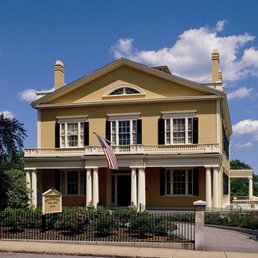

Rotch-Jones-Duff House
396 County Street, New Bedford, MA
This mansion, owned and occupied first by the Rotch family beginning in 1834, then the Jones family beginning in 1851, and finally by the Duff family beginning in 1935, sprawls over an entire city block and spans about one acre. The Greek Revival mansion is recessed from the sidewalk on all sides; on the north and west (Madison and County Streets) the house is positioned about forty feet back from the sidewalks to provide more space for gardens and outbuildings on the south and east of the property. William Rotch, Jr., inherited the property from his father in 1828.
In the nineteenth century, County Street was an upscale residential area, popular for its location away from the commercial waterfront district and wharves. New homes in this prestigious neighborhood (now the County Street National Register District) tended toward the ornate; however, William wanted a house that was less elaborate in appearance and materials.
Over time, each of the three families who lived there made periodic updates to suit their tastes and needs, as would be expected by occupants who had the means to afford the latest developments in technology. Most modifications were typical upgrades for residential comfort such as additional bathrooms, new heating ducts, and electrical lighting; however, all three families strove to preserve character-defining details such as room arrangements and the exterior.
The mansion’s present physical appearance and arrangement are characteristic of its 1834 construction date and strong Greek Revival identity. Rooms are spacious and well-proportioned with large windows protected by paneled folding shutters and varnished mahogany doors with walnut veneered panels and painted casings. The elliptical echinus profiles that are the hallmark of Greek Revival interiors are featured on corner blocks and baseboards. Ceiling cornices and medallions are well executed in plaster ornamentation, and window mountings have a beaded knife blade profile. The house is interpreted through these interior features, the historic furnishings, and period materials spanning the occupancies of the Rotch, Jones, and Duff families in 1834, 1851, and 1935, respectively.
The Rotch family built and owned whaling vessels, supplied materials for shipbuilding, transported and sold whale oil and bone, purchased and sold goods, made candles, and owned wharves and storehouses. Rotch had a close association with black merchant, shipbuilder, and captain, Paul Cuffe. He also hired other people of color as tradesmen and crew. Rotch was one of the staunchest abolitionists in the city and a charter member of several anti-slavery groups. He also regularly hired men and women of color for whaling crews and domestic work. After Rotch’s death, Edward Coffin Jones bought the estate. Formerly enslaved, David W. Ruggles lived and worked for Jones at this estate before moving to California in the 1850s. By 1857 Jones was the third wealthiest individual in New Bedford.
Local history and self-guided tours are presented in collaboration with the New Bedford Historical Society and the New Bedford Whaling National Historical Park. Visitors can also access interactive digital components, VR tours, and videos originally created for the New Bedford Historical Society and UMass Dartmouth’s exhibition, Black Spaces Matter: Celebrating New Bedford’s Abolition Row.
This exhibition will be shown free and open to the public in downtown New Bedford outdoors at the YMCA green space on Union Street, between N. 2nd Street and N. Water Street from June 16 to September 12.
CREDITS
The Black Spaces Matter project is collaboration between UMass Dartmouth College of Visual and Performing Arts students and faculty, local New Bedford experts, and the New Bedford Historical Society.
Black Spaces Matter was exhibited from November 19, 2017 — January 29, 2018 at the Boston Architectural College’s McCormack Gallery, 320 Newbury St. Boston, MA, and from November 8, 2018 — January 30, 2019 at UMass Dartmouth’s University Gallery, 715 Purchase St. New Bedford, MA 02740.
SUPPORT
Black Spaces Matter is supported by New Bedford Historical Society, Creative Economy Fund from the Office of the UMass President, UMass Dartmouth Provost Office, Perkins + Will Associates, Rotch–Jones–Duff House and Garden Museum, Spinner Publications, New Bedford Whaling National Historical Park.
PARTICIPANTS
Consultant: Lee Blake | Lead curator: Pamela Karimi | Architectural renderings, model production, and maps: Pedram Karimi and students in Architecture and Sustainability class | Film, animation, and digital curation: Don Burton | Artistic representations: Michael Swartz | Consultants for the Documentaries: Janine da Silva, Ann Marie Lopes | Advertisement and graphic design: Ziddi Msangi, Racsa Soun, Vasco Pedro and students in Community Engagement Design studio | Digital stations: Michael Swartz, Don Burton, Ben Guan-Kennedy, and Merri Cyr | Production Manager: Jennifer McGrory | Curatorial assistance: CVPA students, Cynthia Raposa, Mark Walker, and gallery director, Viera Levitt.
Events
DATMA Design Days: Eco Art!
DATMA Design Days: Eco Art! 4:00 – 6pm Eco-Friendly Art is an all-ages art project activity where kids and families can explore the importance of recycling and waste reduction, all while transforming discarded plastics and other materials into eco-friendly masterpieces. This free interactive event is for families and kids all ages.
